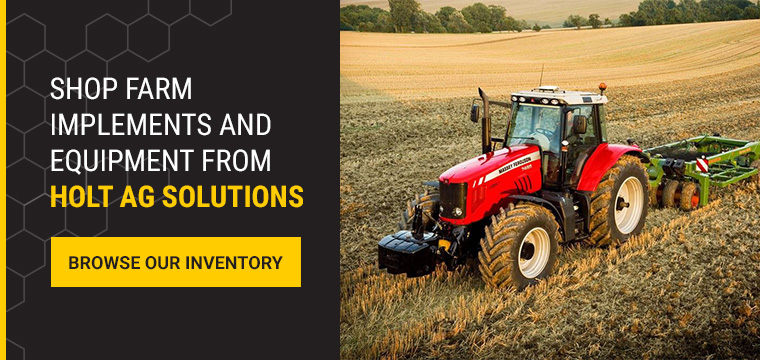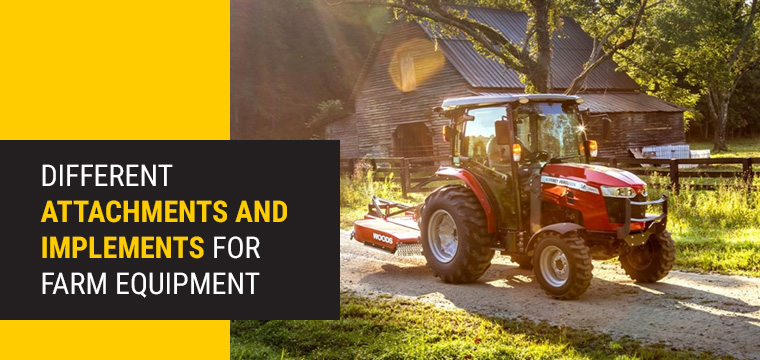
Without farm equipment, many tasks would be significantly more time-consuming and strenuous. Implements offer versatility and give one machine the capability of several. For example, tractor implements are tools and accessories that farmers and agribusiness owners can attach to their tractors to complete various tasks around their property. These implements make it easier to scale earth, dig, move large objects and more.
Farm implements allow you to have the equipment for various tasks without purchasing a different machine for each capability. Read on to learn about farm implements and consider the tools on our tractor attachment list.
Difference Between Farm Equipment and Farm Implements
Farmers use various farm tools, implements and equipment to care for crops and maintain their property. While these terms are similar and often refer to the same items, it’s helpful to define farm implements and farm equipment to see the difference.
What Is Farm Equipment?
Farm equipment typically refers to machines like tractors and harvesters. Mechanized equipment like tractors runs on diesel, petrol, electric or hydraulics to control movement and apply force. Tractors are versatile, allowing farmers to use one piece of equipment for various tasks, making them arguably the most common piece of farming equipment.
What Are Farm Implements?
Farm implements, also called attachments, are tools you can add to machinery to complete various tasks. Different implements serve different purposes. For example, some implements are tools for digging or moving earth, while others cut grass and brush. Depending on the implement’s design and purpose, a tractor may push or pull it.
Farm equipment and tractor implements designed to be used together are important advancements in the farming industry. Implements are what make tractors so versatile, adding value to essential farm equipment.
Importance of Farm Equipment and Implements in Crop Production
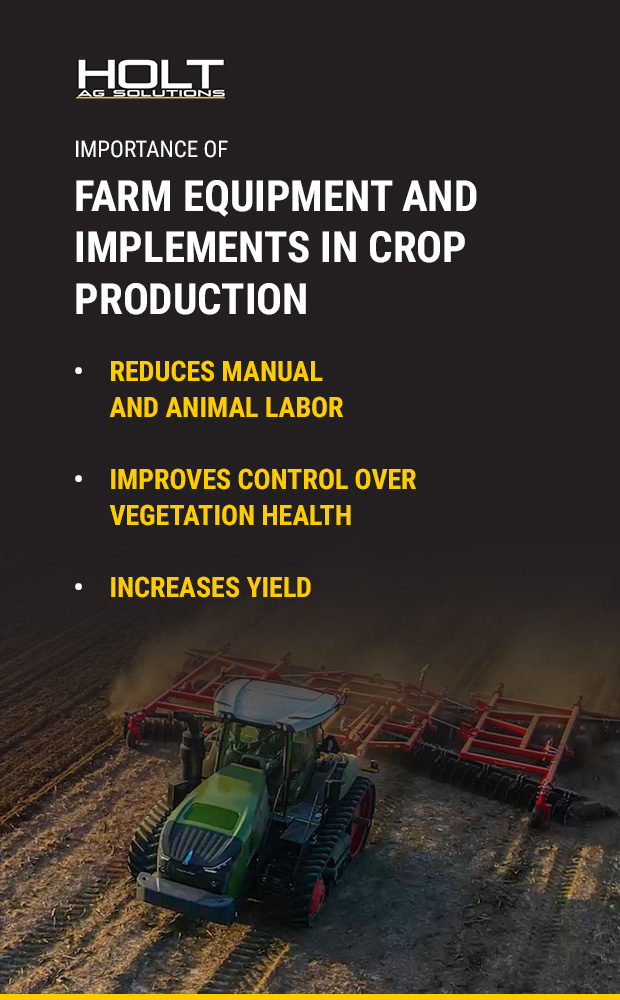
Farm equipment and implements modernized the farming industry and significantly improved crop production. Manual farming methods were extremely time-consuming and strenuous for farmers and their animals. Horses and cattle would pull plows and other tools, while farmers had to use old-school farming tools like a sickle and hoe to tend their crops. They maintained entire crop fields by hand, resulting in long days.
Different farm tools, implements and equipment impact crop production by improving the farming processes. Modern farm machines and implements increase productivity and are significantly more cost- and time-effective. Here are a few reasons farming equipment and implements are valuable for crop production and how they can be beneficial:
- Reduces manual and animal labor: Tractors and other farm equipment have replaced or reduced manual and animal labor. Machines can now do what farmers once did by hand, increasing effectiveness and efficiency.
- Improves control over vegetation health: Before advanced farming equipment and implements, controlling crop health was a significant challenge. Now, these tools allow farmers to quickly and easily spread pesticides and insecticides to protect crops.
- Increases yield: Modern implements and tractors are significantly more efficient than traditional farming methods. With more time and advanced capabilities, farms can complete more crop production.
What Are the Different Farm Implements and Equipment?
Farm implements exist for nearly any farming task imaginable. Having several different tractor implements allows you to complete a broader range of tasks with greater ease. Consider this common tractor implements list to learn the purpose of each and whether it may be a tool you need.
Front Loader
A front loader is a common example of farm implements and equipment. This open bucket attaches to the front of a tractor to perform various tasks — most prominently, moving significant amounts of materials. You can use a front loader implement to transfer manure, fertilizer, gravel, soil, snow or any other material on the farm. Front loader arms can also connect to other bucket designs, pallet loaders and various other tools for optimal versatility.
Backhoe
Backhoe implements attach to the tractor’s rear. They typically have a longer arm than front loaders and feature a small toothed bucket, making this implement ideal for digging. Many farmers also use backhoes for moving dirt and grading, especially for small-scale projects. While backhoes offer less versatility than other implements, they’re extremely powerful digging tools.
Box Blade
Though farmers may overlook a box blade as a necessary tool, most find uses for them. Box blades feature scarifiers to break up the ground before the box pushes it forward and a blade to smooth the dirt out. This implement is pulled behind a tractor for leveling and grading, which is especially useful when creating paths or roads. A box blade can come in handy anywhere you need to move dirt and smooth out the ground.
Post Hole Digger
Post hole diggers attach to the tractor’s rear and bore perfect holes in the ground. This implement is mechanical, connecting to the tractor’s power so the operator can control it from the cab. To create the desired hole size, you can select auger bits with different diameters and lengths. Post hole diggers are primarily used to dig holes for fence posts, though you may also use them when you’re planting trees or shrubbery. If you find yourself frequently digging fence holes, this implement can significantly simplify that task.
Rotary Tiller
Rotary tillers are important pieces of farm equipment that allow you to use your tractor to till your fields. Farmers use rotary tillers to prepare old fields for new crops. This implement features rotating tines that cut into the ground to turn up fresh, loose soil.
Farmers typically till to soften and prepare a field for planting new seeds. Rotary tiller implements are also helpful for tilling cover crops, which protect the soil until it’s ready for your crops. Tilling in cover crops can add nutrients and fertilizer back into the soil.
Spreader
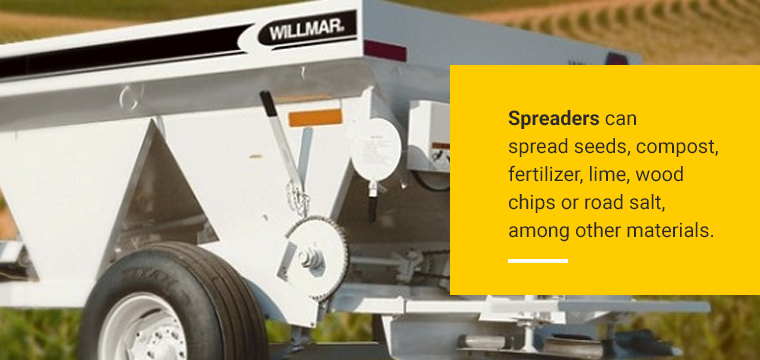
Spreaders are extremely versatile farm implements that scatter materials on the ground. For example, spreaders can spread seeds, compost, fertilizer, lime, wood chips or road salt, among other materials. While you can find spreaders in many different designs, they all feature a hopper to hold the material and a wheel that spins to release the material behind the tractor.
Spreaders can be either ground-driven or power-driven, which refers to how the hopper releases the material. Ground-driven spreaders derive power from the wheel movement and will start spreading as soon as the wheels start moving. Power-driven spreaders connect to the tractor’s power take-off (PTO), giving the operator more control over when the spreader starts releasing material.
Sprayer
You can use sprayers to spread liquid materials over fields. For example, a sprayer implement helps farmers spray liquid fertilizers or pesticides across fields quickly and easily. Sprayers come in various designs and sizes, allowing you to find one that fits your needs. They can also attach to a three-point hitch or the tractor’s rear.
Pallet Fork
Pallet forks can attach to front loader arms in place of the bucket or directly to the bucket. Various industries use pallet fork implements to move pallets and oversized loads. On a farm, forks are versatile, allowing you to move anything from pallets and crates to hay bales and boxed products. You can also use pallet forks to move long objects like pipes or tree branches that wouldn’t sit in a front loader bucket.
Rotary Cutter
Rotary cutters go by many names, including brush hogs or brush cutters. You can use this implement to cut long grass, weeds, brush and shrubs to a more manageable length.
These implements are built to cut tough plant material that a typical grooming mower couldn’t handle. Rotary cutters are ideal for farmers and property owners that need to maintain acreage. You can even use them to chop down long grasses and hay for farm animals.
Grain Cart
Also called chaser bins, farmers use grain carts beside combine harvesters. A tractor will pull a grain cart next to a combine to collect the grain. Since the combine isn’t collecting the grain, it won’t have to stop to unload it before going back to cutting. The grain cart makes collecting and transporting the grain much simpler.
Hay Rake
A hay rake is pulled behind a tractor to arrange hay or straw into neat lines or windrows for baling. Hay rakes can also turn wet hay over so it dries quicker. A series of pronged wheels that create a “V” shape behind the tractor grab loose hay and collect it in rows. You’ll find hay rakes in several sizes and variations to meet different farming needs.
Hay Baler
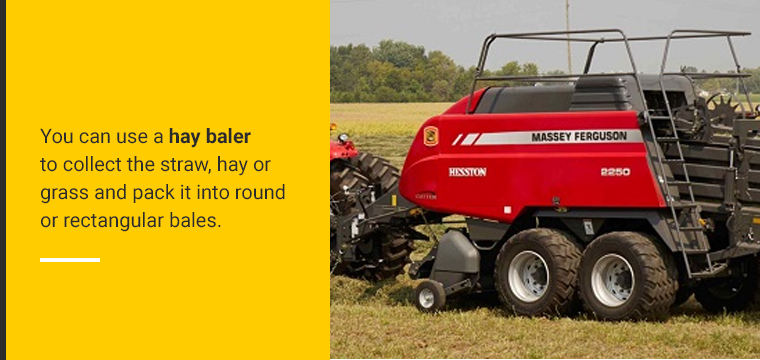
After a hay rake creates windrows of cut crops, you can use a hay baler to collect the straw, hay or grass and pack it into round or rectangular bales. Once the compressed bales dry, you can collect them for sale or use around the farm. Balers connect to the tractor’s PTO and come in various shapes and sizes.
How to Use Tractor Implements
A strong understanding of your farm tools, implements, equipment and their uses allows you to get the most out of your equipment. Knowing how to use your tractor implements ensures you use them properly and effectively.
Before you use a new attachment, you should read the owner’s manual. Every tractor and implement manufacturer is different, and reading the manual provides manufacturer-specific guidelines to help you form a solid foundation of understanding for your equipment.
You should also visually inspect an implement before you use it, regardless of its age. This step helps ensure the attachment is in good condition for use. Check shields and guards around the entire attachment to ensure they’re in good shape and work properly. Look for any signs of damage that may make the implement hazardous to use.
Once you’re ready to use your tractor implements, you’ll need to know how to attach the implements to your tractor. Here’s how to attach an implement to two common types of hitches:
- Hitching to a drawbar: Back your tractor up to the implement to align the drawbar hole with the hole in the implement hitch. Once the hitch is aligned with the drawbar, set the brakes and put the tractor in park to ensure it won’t move while you’re hooking up the attachment. Use the appropriate security clip to secure the attachment in place. Finally, make any electrical, PTO or hydraulic connections the implement needs to operate.
- Hitching to a three-point hitch: The tractor drawbar should be forward to align the draft arms and pin holes with the hitch points on the implement. Adjust the draft arms until they match the hitch points. With the brakes engaged, attach the left and right arms with the corresponding clips and pins. Raise the arms to match the hitch to the upper hitch point and attach the pin.
Be sure to do one last look-over to ensure everything is properly attached and hooked up before putting the implement to work.
How to Store Tractor Implements
Just like any of your farm equipment, you need to store your tractor implements properly to prevent damage and unnecessary wear and tear. Most implements take up significant space, so you’ll want to ensure you have somewhere to store them, especially if you have or plan to get several. It’s best to store implements indoors and off the ground.
For example, an ideal storage setup would be in a garage, barn or shed with low shelves or pallets to put the implement on to keep it off the floor. This setup will most effectively protect your equipment from the weather, moisture and other elements that can damage it.
If indoor storage isn’t an option, try to keep implements under overhangs or covered with tarps. Take any action possible to keep your implements protected. Keeping weather and debris off your implements and any farm equipment will go a long way in preserving your investment for years to come.
Shop Farm Implements and Equipment From Holt Ag Solutions
If you’re in the market for new farm equipment or implements, Holt Ag Solutions has the inventory for you. Whether you’re looking to replace your old tractor or want to purchase your first implement, we offer a variety of high-quality farm equipment.
From hay implements to name-brand tractors, we can help you find the right equipment for your agribusiness. Our experienced team offers personalized services that keep your equipment running smoothly long after you’ve made your purchase. From preventive maintenance to emergency repairs, we’ll be your partner for life.
Contact our team for more information regarding our farm implements and equipment.


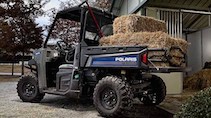 Farm Tax Exemption Form
Farm Tax Exemption Form